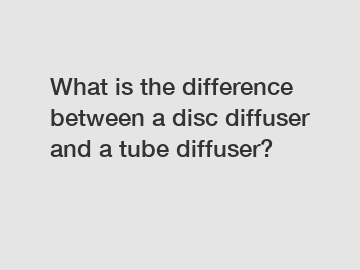What is the difference between a disc diffuser and a tube diffuser?
What is the Difference Between a Disc Diffuser and a Tube Diffuser?
In wastewater treatment plants, aeration is a critical process that plays a crucial role in the biological treatment of wastewater. One of the key components of the aeration system is the diffuser, which is responsible for introducing oxygen into the wastewater. There are two common types of diffusers used in wastewater treatment plants: disc diffusers and tube diffusers. While both serve the same purpose, there are several differences between these two types of diffusers that should be taken into consideration when designing an aeration system.
Disc Diffusers:

A disc diffuser, as the name suggests, consists of a circular disc-shaped membrane made from materials like EPDM or silicone. This disc membrane contains a number of fine pores through which the air is released into the water. The disc is typically mounted horizontally on the bottom of the treatment tank or basin.
Efficiency and Oxygen Transfer:
Disc diffusers are known for their high oxygen transfer efficiency. The fine pores in the disc membrane create numerous small bubbles, which allows for increased contact area between the air and the water. This results in more efficient oxygen transfer, ensuring that an adequate amount of oxygen is supplied to support the biological treatment process. The high oxygen transfer efficiency of disc diffusers makes them popular in large-scale wastewater treatment plants.
Maintenance and Cleaning:
One advantage of disc diffusers is their ease of maintenance and cleaning. The disc-shaped membranes can be easily removed for inspection, cleaning, or replacement. This makes routine maintenance activities simpler and more cost-effective. However, it is important to note that disc diffusers are more prone to fouling and blockage due to their design. Regular cleaning and inspection are necessary to prevent performance issues caused by deposits or blockages.
Tube Diffusers:
Tube diffusers, on the other hand, consist of long cylindrical tubes made of materials like EPDM or polyurethane. These tubes are typically installed vertically in the treatment tank or basin and are connected to a header pipe through which compressed air is supplied.
Bubble Size Distribution:
One of the key differences between disc diffusers and tube diffusers is the bubble size distribution. Tube diffusers produce larger bubbles compared to disc diffusers. While this may seem like a disadvantage, there are applications where larger bubbles are advantageous. For instance, in activated sludge processes with higher solids concentration, larger bubbles can improve mixing and prevent settling of solids.
Flexibility and Layout:
Tube diffusers offer more flexibility when it comes to system layout and design. The cylindrical shape allows for easy installation in a wide range of configurations, including curved or U-bend designs. This flexibility can be particularly useful in retrofitting or upgrading existing aeration systems.
Conclusion:
In summary, both disc diffusers and tube diffusers are effective in introducing oxygen into wastewater for biological treatment. The choice between the two depends on various factors, such as the size of the treatment plant, oxygen transfer efficiency requirements, ease of maintenance, and system layout. While disc diffusers offer high oxygen transfer efficiency and easy maintenance, tube diffusers provide flexibility in system design and layout. By understanding the differences between these two types of diffusers, wastewater treatment plant operators can make informed decisions regarding the design and operation of their aeration systems.
If you have any further questions or would like assistance regarding disc diffusers, tube diffusers, or any other aspect of wastewater treatment, please do not hesitate to contact us. We are here to help.
If you want to learn more, please visit our website Steel water tank, cross flow vs counter flow, vinyl seawall installation.
121
0
0


Comments
All Comments (0)